The advertising industry had already taken its modern shape even before World War I, as marketers came to understand the power of brand identity. Walter Haskell Hinton entered the work force in 1905 at age 18, motivated to climb to the top by the need to support himself and his mother after his father’s unexpected death.
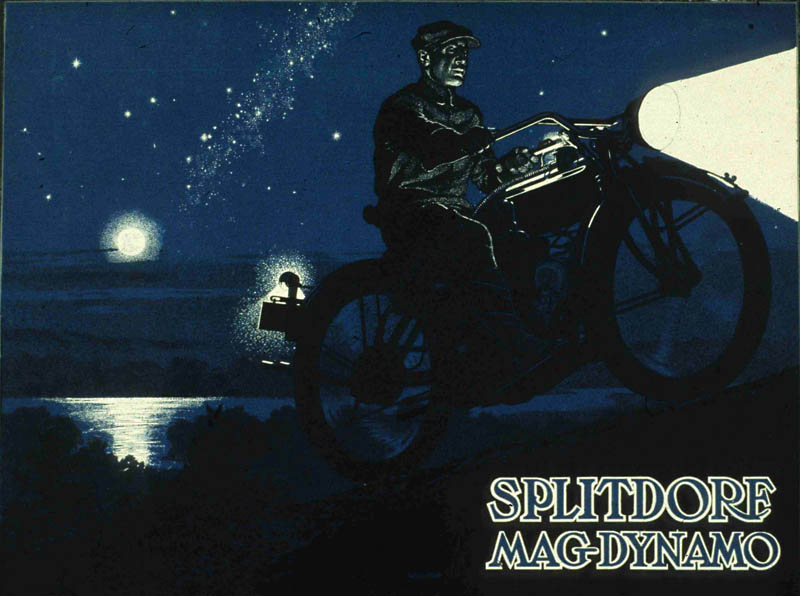
Living in Chicago meant he was in close proximity to many manufacturers in Wisconsin, Illinois, and Minnesota. Early on, his portfolio filled with advertisements for motorcycles, locomotives and cars, which foreshadowed his later work for John Deere, Austin-Western, and Fairmont Railway Motors. He may have made this ad for Splitdorf Magneto while he was living in Milwaukee, where he worked for Hall Taylor and then Cramer Krasselt (which is still in business today!). I haven't yet determined what the ads for Performance below were made for yet, but there were several versions.
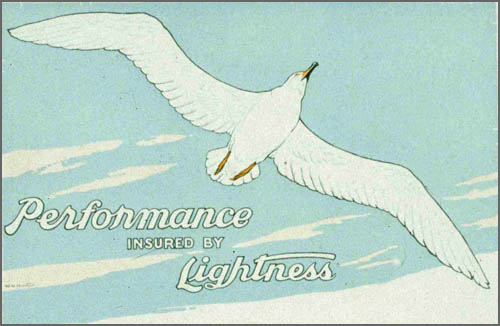
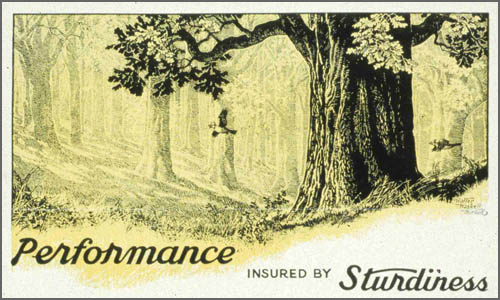
Hinton went to New York in 1912, but he thought the city “miserable.” He soon moved on to Philadelphia. There, he had a studio near the Saturday Evening Post. We know he got some illustrations into the Post, but these have yet to be located (if you see them, tell me!)
In Philadelphia Hinton soon began working on some large accounts, such as for Old Dutch Cleanser, as a freelancer. He may have designed the campaign below, which he said simply showed women using the product in different ways; the company continued to use this look and feel for many years.
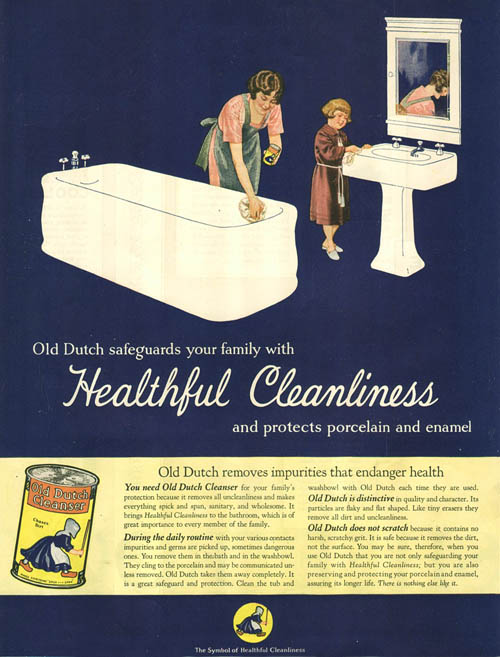
Hinton excelled at design and illustration, but what really made him successful was his ability to come up with effective advertising strategies. One of his biggest accomplishments was his invention of the mascot Velvet Joe for Liggett & Myers’ pipe tobacco in 1917. In a 1976 interview Hinton recalled:
"When I was down east, I originated a “type” down there that was very famous. It ran for five years, and people were writing in all over the country: “Is there such a person as Velvet Joe?” …the advertising was so good – I didn’t smoke – the advertising was so doggone good on pipe smoking that I became a pipe smoker!"
"I said, 'I’ll tell you what I’d like to see on Velvet Joe. I’d like to see a blend of Mark Twain and a friend of mine who looks very much like him, a blend of those two to create this type.' So I made a sketch and they were all for it so our whole series went that way."
Using the writer Mark Twain as a model was appropriate because the ads ran in Literary Digest.

Hinton also sculpted a bust of Velvet Joe that guided another illustrator, Leone Bracker, who was hired to do the final artwork below (Hinton got to illustrate a different campaign for Velvet Tobacco later).

Hinton also helped write the amusing verses that accompanied some of the ads, “And boy did that stuff go over!” he remarked. Unfortunately, “I never got any credit myself,” he continued. “They didn’t let me sign [the bust], and oh the thing was famous, but oh boy was I cheated on that one!” An article in a Saturday Evening Post on the originators of famous ad campaigns even attributed Velvet Joe to another man (again, if you see this article, please tell me!).
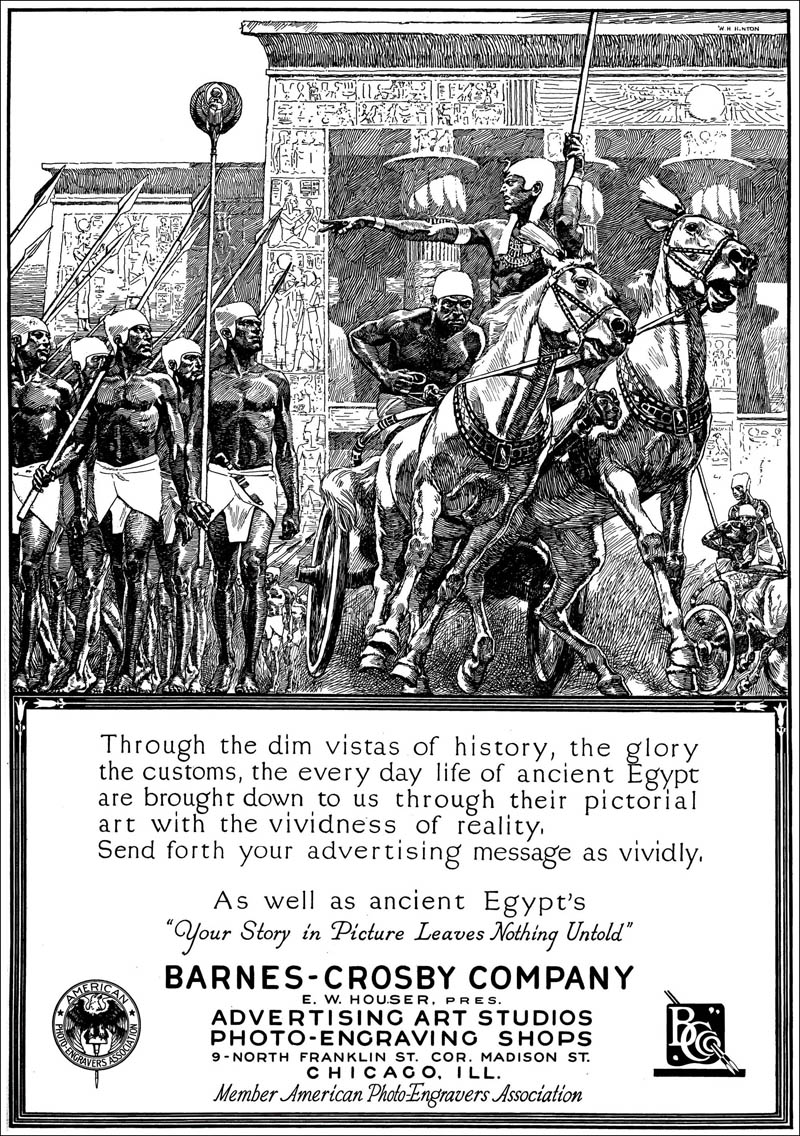
Hinton returned to Chicago in 1919, and soon was made the senior artist at the Barnes-Crosby agency. There, he developed promotions for the agency itself, where illustration played a key part in the company’s services. The slogan of the series was, “Your Story in Pictures Leaves Nothing Untold.” Comparing advertising art to art of ancient civilizations, copy informed the client that, “our modern advertising can be made to live on the printed page by the use of convincing and realistic illustrations.” In these, Hinton indulged his taste for drawing horses, indigenous peoples, and exotic historical scenes.
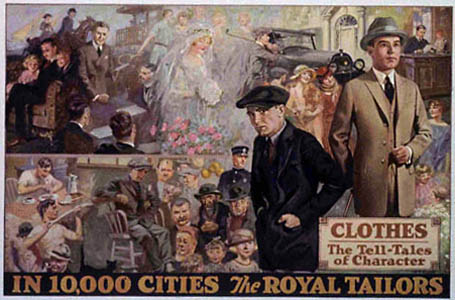
Hinton continued to work on a wide variety of subjects, one of which was fashion. The 1920s was a time of socioeconomic class fluidity, with the population beginning to migrate from farms to cities. Ready-made clothing was relatively new, and as this ad indicates, clothing was used to convey respectability. The upright gentleman gets married, has a nice house, and succeeds at business, while his shady counterpart is associated with police and a courtroom.

Men entering white-collar professions and their wives suddenly provided a large consumer market – momentum was building up to the eventual stock market crash of 1929. Advertising was blamed for fueling debt and desire (sound familiar?). This Miss Tokio ad, with its background of gold leaf (approximated here by the magic of Photoshop), levered the supposedly exotic mystique of Japan to seductively promote hosiery, a luxury newly sought after as long Edwardian skirts were abandoned by the liberated "new woman".
Like other illustrators during the Roaring Twenties, Walter Haskell Hinton was well paid and respected. Soon, however, he would be thrown back into the unpredictable world of freelancing.
Continued tomorrow...
* Jaleen Grove's critical biography of Walter Haskell Hinton, published by the Ewing Gallery at the University of Tennessee, began as a fairly brief exhibition catalog essay. It grew into a 96-page book when a wealth of interviews and primary documents were obtained. The book differs from this series on Today’s Inspiration in that it explores key issues in the cultural production of commercial art, both the troubling aspects of mass-culture images and the material pleasures of them.
Because it is a non-profit educational endeavour for which she volunteered her time, Jaleen would like to invite you to advance-order a copy or donate to the project, to help with production and distribution costs.
* Walter Haskell Hinton official website






0 comments:
Post a Comment